This CE Center article is no longer eligible for receiving credits.
Aluminum, as a material, is incredibly versatile and has been used in a wide range of products for centuries. In modern construction, aluminum has been tapped as an ideal material for doors and window frames to promote durability, energy efficiency, sustainability, and to manage budget expectations. Compared to other fenestration and dooring materials like wood and vinyl, aluminum offers an environmentally responsible alternative, helping reduce waste, conserve natural resources, and provide long-lasting performance. For the architect, specifying doors and windows of the same material type from a single source for the entire project can offer additional benefits, including consistent design options, reliable supply chain delivery, and a better supported installation. This article examines the unique qualities and benefits of specifying windows and doors from a single source, manufactured with aluminum for residential, commercial, and public building projects. Aluminum extrusions combined with innovative thermal barrier materials save energy, increase healthy indoor air quality, and improve safety, sustainability, and aesthetics. Case studies are incorporated to help provide real-world examples of how using aluminum that is single-sourced for all windows and doors can support both sustainability and project goals.
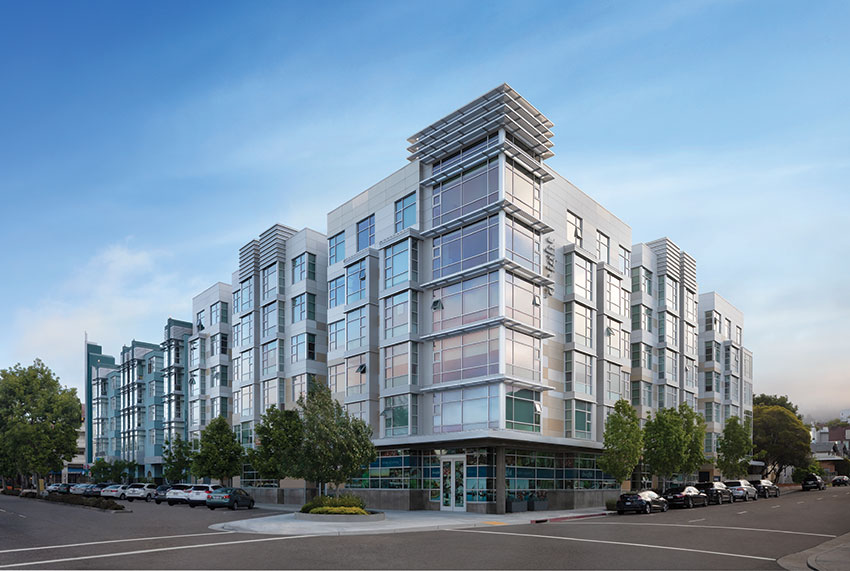
Photo by Chip Allen Photography; courtesy of All Weather Architectural Aluminum
The Dwight Modern, in Berkeley, Calif., is a mixed-use development highlighted by 99 high-end, modern apartment homes. Aluminum windows and doors complement the contemporary aesthetic while providing durable, low-maintenance finishes.
FLEXIBLE DESIGN DURABLE LONGEVITY
Aluminum remains one of the most specified materials in the residential and construction industry, as its advantages are long-lasting. Durable, flexible, impermeable, and strong, this metal has proven to be an increasingly valuable asset for architects and builders. Aluminum weighs 65 percent less than steel but is 43 times more powerful than wood, and its tensile strength is as high as 90,000 psi. In the age of sustainable design, recycling, and monitoring our collective carbon footprint, aluminum has prevailed as the building material that checks all the right boxes.
For architects, the benefits of specifying aluminum can lead to an expanded creative pallet, more options for sustainable building credits, and a simpler design path. This material offers an array of benefits when it comes to single-source solutions, where both windows and doors are obtained from a single manufacturer. This approach streamlines the construction process, improves lead times, enhances design flexibility, simplifies installation, and provides comprehensive BIM (Building Information Modeling) support.
Aluminum is lightweight, workable, and corrosion-resistant, so it is a great choice for healthy and sustainable buildings. Aluminum is 100 percent recyclable, which is important in reducing construction waste that cannot be reused. Aluminum framing also is growing in popularity in North America because it can support indoor air quality (IAQ). Its ability to combine with other products that enhance air quality in a structure has increased its demand. Aluminum also requires minimum maintenance after installation. In general, periodic washing with soap and water is all that is required, but manufacturers supply specific information as needed.
Aluminum meets sustainability expectations thanks to its environmental advantages. Commercial building developers looking for improved energy efficiency can choose high-performance aluminum windows and doors with a range of profiles and colors, allowing for design capabilities that can support overall appeal and brand. Within these choices, however, a builder will increase the likelihood of success in terms of both aesthetics and sustainability when working with a single manufacturer across all stages of a project.
When it comes to thermal comfort, aluminum windows, and doors serve as part of a larger system. Because aluminum is a conductor of heat, aluminum frames must be equipped with a thermal barrier that prevents heat from flowing inside to outside or vice versa depending on the climate, time of year, or time of day. This is another reason to work with a single manufacturer who can ensure quality control of sourcing throughout construction.
Durability, daylighting, and acoustic performance are other advantages of high-performance aluminum windows and doors. The strength of aluminum enables glass-clad structures to meet wind load provisions. The slimmer profiles of extruded aluminum window and door frames increase the amount of daylight entering the window, sometimes by as much as 20 percent. Reduced sound levels reduce stress in healthcare facilities and improve productivity in workplaces.
In addition, aluminum thermal barrier technology is working even more closely in conjunction with glass, glazing, and envelope materials to reduce commercial building energy consumption. Double- and triple-pane windows and doors are now often filled with inert gases such as argon or krypton to reduce convection within the units and to improve the window or door’s overall energy efficiency. These gases are often known to leak—many times at a rate of just 1 percent a year, which is generally acceptable. However, sometimes if the seals are not sufficient, they will leak faster, thus ruining their contribution toward energy efficiency and necessitating an expensive replacement. Aluminum can be fabricated to extremely close tolerances to create precise forms for the insertion of glazing, weather stripping, and thermal barriers to control this leakage. The prime factor related to fire is the glazing, but noncombustible aluminum frames hold the glazing longer than many other framing materials. Double glazing provides better protection than single glazing. Tempered glass, which is four times stronger (more resistant) than single-pane annealed and twice the strength of a dual pane, increases the fire resistance further.
The positive attributes of aluminum, which include strength, stiffness, flexibility, durability, corrosion resistance, and nontoxicity, combined with its ability to be recycled and reused indefinitely without a loss of any of these attributes make aluminum one of the most sustainable and beneficial building materials in current use. Aluminum can be finished and colored in a number of ways and thus provides designers with a generously wide choice of design options, along with the knowledge they are using a safe, affordable, healthy, and sustainable material.
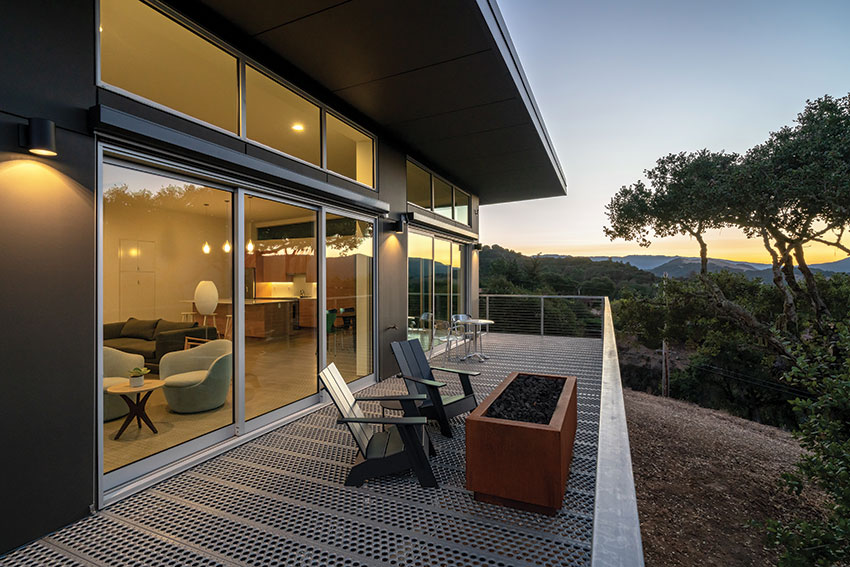
Photo by David Lalush; courtesy of All Weather Architectural Aluminum
The Waterfall Residence incorporated aluminum doors and windows to match the overall industrial aesthetic of the home, while also complying with the sustainable net-zero energy goals.
DESIGN MEETS FUNCTION: THE WATERFALL RESIDENCE
Set in the picturesque Carmel Valley in Monterey County, California, the Waterfall Residence had sustainable performance aspirations as high as the visual design goals.
Architect Andrew Goodwin, owner and architect at AGD Architecture + Design, was tasked with designing the Waterfall Residence to embrace the natural aesthetics of the local forest of old-growth oak trees, but with a striking industrial and contemporary feel. At the same time, the home needed to achieve the U.S. Department of Energy’s Zero Energy Design Designation.
“The design was intentional in its desire to look more like a solid object or industrial artifact. Since the building structure was light gauge steel and the exterior appeared as if it were industrial in nature, the windows had to match this aesthetic,” Goodwin said. To match the contemporary aesthetic and ensure a high-performance design, Goodwin specified dual-glazed aluminum sliding door and window frames. “Aluminum windows gave the design team a contemporary option that would match the whole house design.”
In a strategic effort to avoid disturbing the dozens of old-growth oak trees on the property, and to mitigate the site’s elevation change of 75-plus feet, the architects opted to lift the 2,330-square-foot home into the tree canopy, ensuring spectacular views that overlook the valley in three directions–east, west, and south.
“The Waterfall Residence was designed to have a significant amount of glass,” Goodwin said. “It was important to not only have material that would be durable for decades but also would perform well thermally.” Most of the views from the residence were to the south, and so even with a large overhang, the windows needed to have superior thermal performance.
“By using a thermally broken design with a high U-value, we were able to make the home perform well while maintaining the views and connectivity to nature,” he said. “Aluminum windows have proven to provide these great solutions while also not being overly expensive.”
Aluminum inherently possesses many of the qualities that Goodwin was searching for when designing the Waterfall Residence.
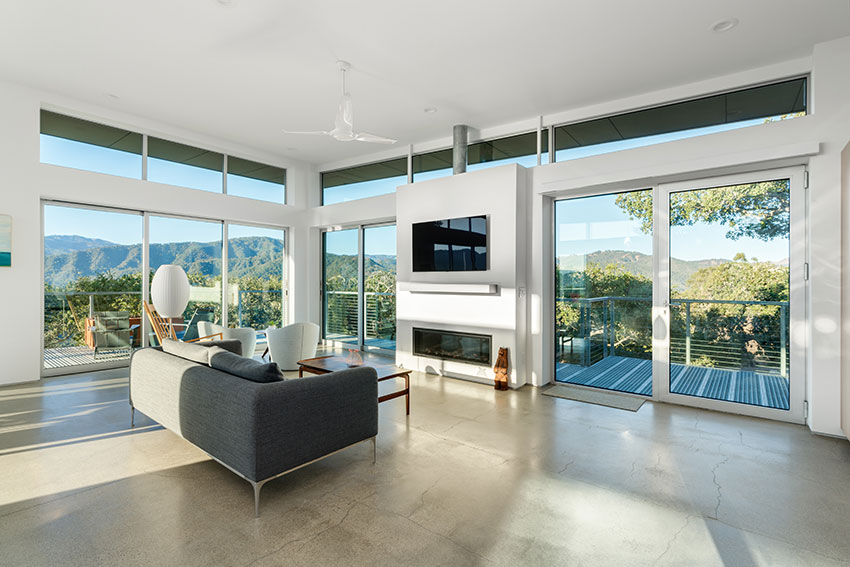
Photo by David Lalush; courtesy of All Weather Architectural Aluminum
Large aluminum windows and sliding doors allow the Waterfall Residence access to both sweeping views and natural daylight, reducing the energy demand for artificial lighting.
“The basic physical attributes of aluminum windows allowed us to minimize the window frames for a more aesthetically pleasing connection to nature from the inside of the home,” he said. Aluminum provided the team with a lightweight and durable material that turned out to also be low maintenance in the long run. This low maintenance advantage was equally effective on the inside and outside of the home. By avoiding wood frames that age and require maintenance even after a short period of time, the team could focus on the ease and superiority of delivery as well as the longevity of aluminum.
Aluminum also played a role in the overall earth-friendly strategy of the Waterfall Residence.
To achieve a Zero Energy Design designation, the three-bedroom house was equipped with mainly electric appliances and onsite power generation provided by a 6.5-kWh solar array. Further enhancing the sustainable design, a rainwater collection system off the rear of the home–designed to emulate a waterfall–funneled stormwater into two 2,000-gallon tanks under the home.
The Carmel Valley climate includes fluctuating temperatures and risk of fire, so the home was designed to resist these elements while also providing sustainability in both energy efficiency and material selection. The aluminum windows provided an option for recyclability and durability while contributing to the energy efficiency of the home. “The home was designed to be sustainable and resilient,” Goodwin said.
“The choice to have aluminum frames for doors and windows provides so much more than just an aesthetically superior option for contemporary residences and commercial projects,” he added. “But much like an automobile, you feel the difference when up close to an aluminum or metal frame compared to vinyl, fiberglass, or the like. The feeling of an aluminum frame adds sophistication and weight to any detail. It feels more prominent and thus your project will reap the benefits of material that is strong and timeless.”
ALUMINUM: THE ORIGIN STORY
To understand the benefits of aluminum as a building material, it is important to learn how this metal was first discovered and processed. In 1887, Austrian engineer Carl Josef Bayer developed a chemical process to extract alumina from bauxite, the third most plentiful ore on earth. The basic process is still used today. In 1888, the Pittsburgh Reduction Company launched the first smelting plant in North America. Aluminum is now produced with far less energy and at a much lower cost. In the early 1920s, for example, the cost of aluminum was reduced by 80% because of innovations in the production process.
Unlike other metals with limited supply, known bauxite deposits are sufficient to support the current production rate of aluminum for another 300 years. Open-cast methods are usually used, and great care is taken to restore and revegetate mine sites. Globally, the area rehabilitated each year equals the area being mined.
Aluminum alloys mix aluminum metal with other elements such as copper, magnesium, manganese, silicon, tin, and zinc. They can be processed into different forms depending on the method of processing. The extrusion process, which forms longer, thinner pieces, is often used in the building industry, mostly for manufacturing doors and windows.
Because aluminum instantly forms a tenacious oxide film that provides protection against corrosion after extrusion, it has an advantage over steel where the iron oxide (rust) in steel can spall off to expose the metal to corrosion. For aluminum solutions, additional finishing is generally not needed except for aesthetic or severe service conditions (e.g., salt spray, heavy pollution). When additional finishing is desired, anodizing or paint (either liquid or powder) is typically specified. Anodizing is an electrochemical process that thickens and toughens the naturally occurring protective oxide.
Liquid and powder coatings are multistep processes that coat and protect the aluminum substrate and enhance its appearance. The processes range from a single-coat liquid or powder to a four-coat polyvinylidene fluoride (PVDF) liquid using a primer, barrier coat, color coat, and clear coat. Powder coating provides excellent hardness and mar resistance, while liquid coatings can utilize a protective primer and metallic topcoats to achieve many unique appearances. Fluoropolymer systems have been the first choice for curtain walls for many years, and they are still considered the premier system for this application.
Mechanical finishing, such as brushing or sandblasting, is also employed occasionally. Most extruders have either in-house paint and/or anodizing capabilities or finishing service relationships that facilitate a finished and fabricated component. American Architectural Manufacturers Association (AAMA) specifications 2603, 2604, or 2605 are generally used to define paint finish performance and parameters, while AAMA 611 Class l or Class ll specifications are used to define anodizing.
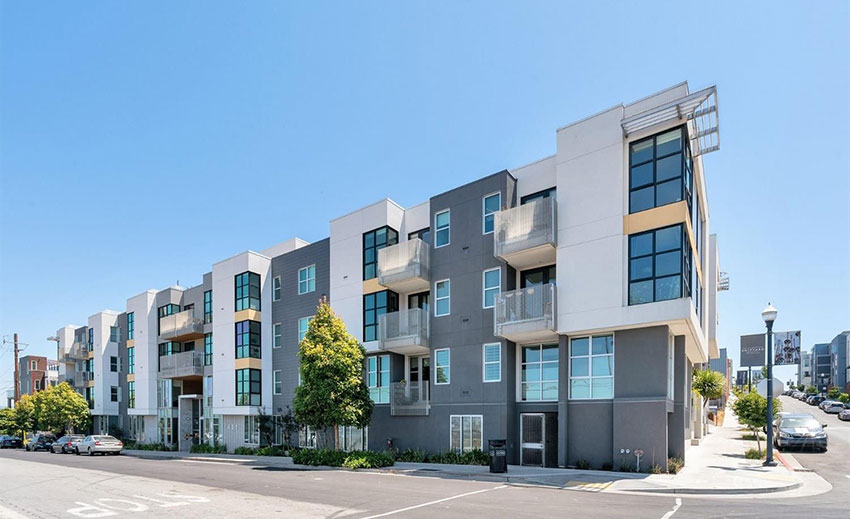
Photo by Philippe Newman; courtesy of All Weather Architectural Aluminum
Selection of coatings for aluminum fenestration particularly Class I anodization is critical to ensure both aesthetic appeal, design consistency, and durability. The Shipyard Condos at Hunters Point.
THE BENEFITS OF SINGLE-SOURCE SPECIFYING
Before getting into the multitude of practical and performance benefits that aluminum can offer as a fenestration material, it is important to address the advantages of using a single-source manufacturer for fenestration products. Using a single-source provider of fenestration products can help architects and designers throughout the design process and also help streamline the construction and installation phase. Some of the main benefits of sourcing fenestration from a single-source manufacturer include consistency of product, ease of ordering, simpler integration with plans and schedules, and enhanced support from manufacturers.
Consistency
Likely one of the strongest arguments for selecting a single-source manufacturer for aluminum fenestration is the consistency of product. From a visual standpoint, having all window and door frames produced in the same factory-controlled environment by a single source ensures that everything from base extrusion to finishes will be the same. This is especially true for higher-end projects that call for multiple types or styles of fenestration within the same project. Specifying all fenestration from a single source will ensure that there are no batch differences in finishes. Additionally, when all fenestration is produced from a single source, products will age at the same rate. This can be especially important when anodizing for challenging environments where fenestration will be exposed to extreme heat, cold, UV radiation, or sea salt.
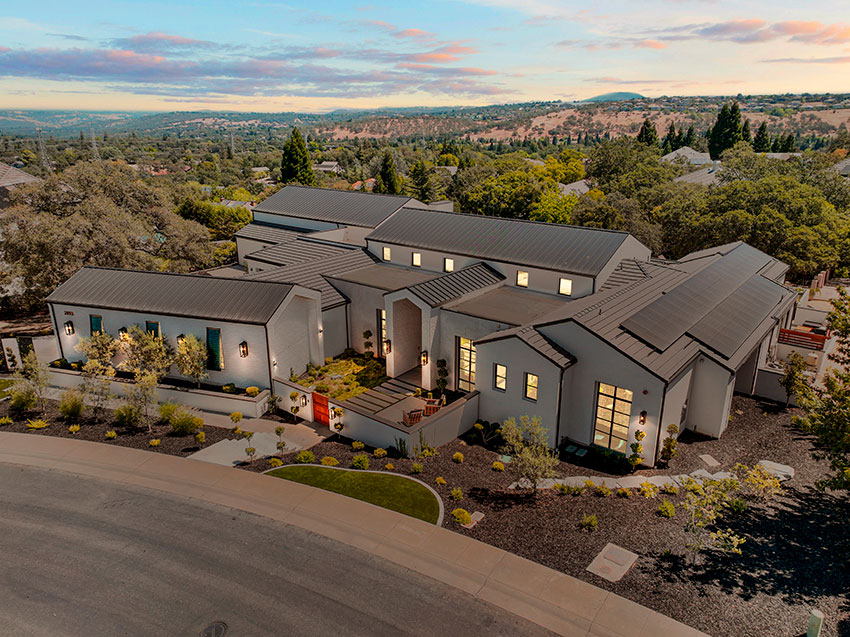
Photograph by Miles Minno; courtesy of All Weather Architectural Aluminum
The fenestration in the Capetanios Residence in El Dorado Hills, Calif. was sourced from a single manufacturer to ensure cohesiveness in the profiles and color across the entire project.
Ease of Ordering
he simplicity of dealing with a single-source manufacturer cannot be overstated. Architects often find themselves managing a myriad of suppliers for different components of a project. By consolidating the aluminum fenestration with a single manufacturer, the ordering process becomes more straightforward, reducing administrative complexities and the potential for miscommunication. This results in a more efficient workflow, allowing architects to focus on the creative and technical aspects of their designs rather than navigating through multiple procurement channels. Single-source manufacturer selection can often result in greater discounts and simpler warranty documentation.
Integration with Design
As noted above, consistency of product is a strong motivator for selecting fenestration from a single source, however, the technical integration of materials and products is also important. Coordination and compatibility issues are minimized when all fenestration components come from the same source. This ensures that windows and doors seamlessly integrate into the overall architectural vision, promoting design coherence, and aesthetic consistency as well as supporting performance goals. If attempting to qualify for green building certification programs, a single-source manufacturer can provide Environmental Product Declarations (EPDs) for each type and unit as a package, helping maintain accurate documentation.
Manufacturer Support
A final benefit of working with a single-source manufacturer is that the relationship often translates to better customer support and a more streamlined communication process. Architects can establish a direct and cohesive relationship with a dedicated contact person, fostering a more collaborative and responsive partnership. This enhanced communication helps address any concerns promptly, reducing the likelihood of project delays and ensuring that the final product aligns closely with the architect's vision. In addition, some manufacturers can provide a more holistic support network for architects and builders that includes everything from Building Information Modeling or BIM files specific to the fenestration type to supporting installation training and best practices during construction.
CAPETANIOS RESIDENCE–A SINGLE-SOURCE STORY
When the builder is the homeowner, material selection and quality construction are brought into sharp focus. Such was the case for Dustin Smith, President of Smith Development and Construction Company when they designed and built their home, the Capetanios Residence, in El Dorado Hills, Calif.
The project called for large windows and doors, allowing ample views of the exterior and providing natural lighting for the Scandinavian-inspired open floor plan. To achieve the contemporary, streamlined look of the project, Smith chose aluminum fenestration throughout.
“Having a larger single framed opening was our goal; the best way to achieve this was through the use of aluminum windows and doors,” Smith said. “The fact is that larger windows with more glass are achievable with aluminum doors when compared to wood, fiberglass, and vinyl.”
Along with the aesthetics, the physical properties of aluminum also were key in the material selection process. As a seasoned veteran in the construction business, Smith understood the necessary balance between budget and quality.
“As the homeowner on this project, I felt the initial investment made the most sense, practically speaking,” he said. “Because of the longevity and lack of ongoing maintenance found in wood windows, the durability of aluminum played an important role in my decision.”
From the position of being a veteran homebuilder, Smith also had the insight to understand how fenestration choices impact the installation process. When specifying design elements and materials, Smith was able to use their unique perspective to avoid potentially challenging installation issues.
“Using aluminum products on residential projects provides designers and homeowners with several benefits. One that specifically comes to mind would be having one large unit such as a mulled unit, or in my case having a double mulled, top and bottom unit, that installs as one unit. The single installation allows me to have less flashing and therefore water intrusion concerns,” Smith said. “Often large expanses of glass are achieved by having wood framing and flashing between each of several smaller windows. As a professional contractor, this is a liability as it is difficult to waterproof.”
After the decision to specify aluminum fenestration throughout, Smith then had to decide whether utilizing multiple or single-source manufacturers to fabricate the custom windows was appropriate. In the end, Smith chose a single-source provider.
“Choosing products from a single source was critical in our decision. When you are building a higher-end custom home in our market, aesthetics play an important role,” he said. “Having cohesiveness in the profiles and color of the aluminum between doors and windows was a major factor in going with a single-source manufacturer for our entire home. “

Photograph by Miles Minno; courtesy of All Weather Architectural Aluminum
Aluminum frames were specifically selected for the multi-slide patio door panels on the Capetanios Residence to achieve a streamlined, contemporary aesthetic and to improve the glazing-to-frame ratio.
TAKING ALUMINUM FULL CIRCLE
Part of the unique qualities of aluminum include sustainable attributes. These can be highly desirable when pursuing green building programs like the Leadership in Energy and Environmental Design (LEED) green building certification program, developed by the U.S. Green Building Council. While aluminum offers a wide range of environmentally responsible benefits based on performance, one of the most significant sustainable benefits is the end-of-life recyclability of the metal.
Aluminum is 100% recyclable and retains all its properties indefinitely. It takes just 8% of the energy required to produce products from raw aluminum to recycle aluminum, and it creates just 8% of the emissions of primary production. A 10% increase in recycling rates decreases primary energy demand and greenhouse gas emissions by 15%.
Annual benefits of recycling include saving about 70 million barrels of crude oil, 2.4 million acres of land, 45 million tons of fresh and seawater usage, 7.5 million tons of solid waste, and 27 million tons of CO2.
Aluminum is one of the only materials in the consumer disposal stream that more than pays for the cost of its own collection. A 2004 study by Delft University of Technology in the Netherlands concluded that roughly 95% of the aluminum collected from buildings is recycled.
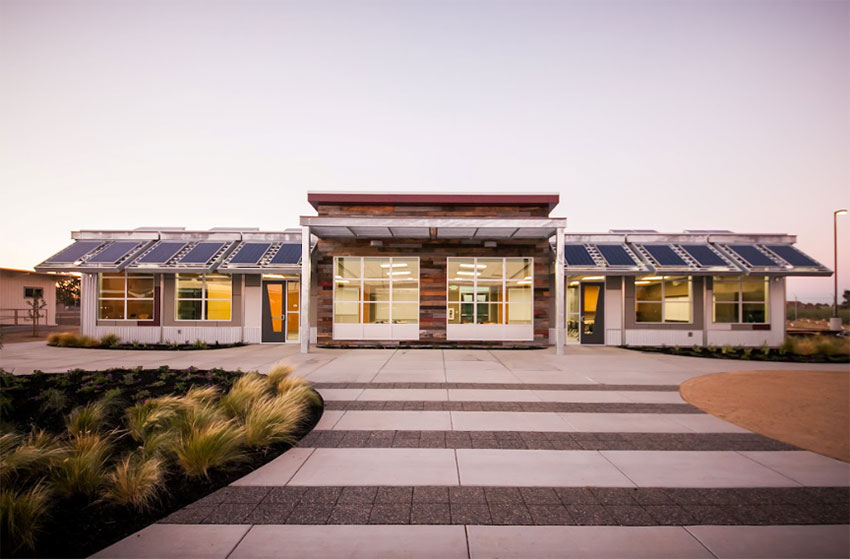
Photo by American Modular Systems; courtesy of All Weather Architectural Aluminum
Because of the unique environmentally responsible qualities of aluminum, the metal can easily contribute to the sustainability and IEQ goals of a project. The Manteca RECA.
ALUMINUM AND SUSTAINABLE DESIGN
As noted above, aluminum as a building material can contribute to a wide range of green building certification and third-party rating programs in several areas, including energy efficiency, material sustainability, and indoor environmental quality. This is especially true for fenestration. The use of aluminum extrusions allows architects to meet the challenges of sustainable design and provides many benefits to the whole-building design concept.
Aluminum-framed products meet thermal performance requirements with increased use of thermal barriers, low-E glass, and triple glazing. Aluminum windows and doors help satisfy daylighting requirements, aluminum sunshades help meet shading requirements, and aluminum products contribute to the sustainable material requirements. All told, aluminum is capable of meeting or exceeding every standard for high performance currently on the market.
For instance, U-factors for the 2021 International Energy Conservation Code (IECC) had significant changes from the 2018 version. Aluminum windows and doors can meet the thermal requirements of all these codes with increased use of thermal breaks and upgraded glazing strategies. In addition, they can satisfy all daylighting requirements. Daylighting is also becoming a more important consideration as there is a steadily rising focus on occupant health and well-being in building design and certification.
It is also important to note that the durability of aluminum provides for a long life. In North America, it is estimated that at least 85% of all aluminum shipped to the construction sector is still in productive use today, 12% has been recycled in the form of end-of-life scrap/resource, and only 3% has been lost in the natural environment.
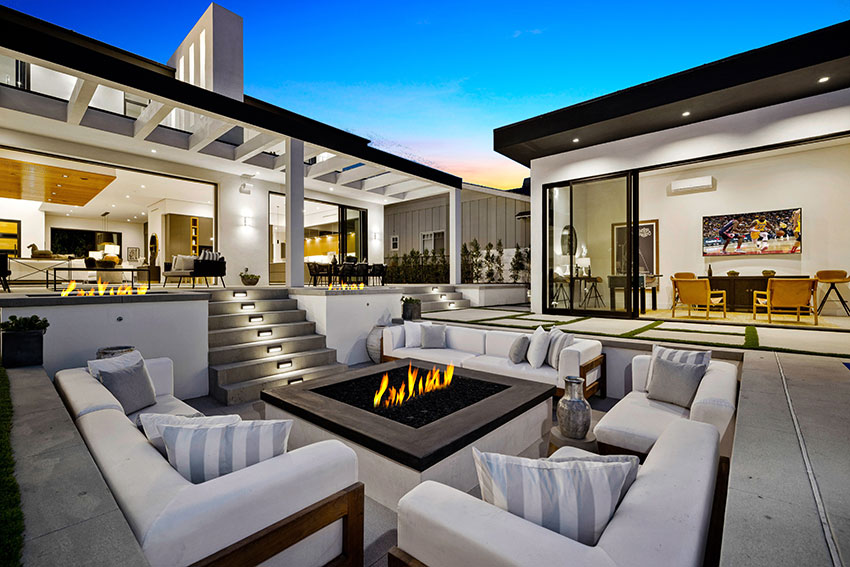
Photo courtesy of All Weather Architectural Aluminum
The Brewster Estate utilized matching aluminum windows and large sliding doors to create a contemporary flow from interior to exterior.
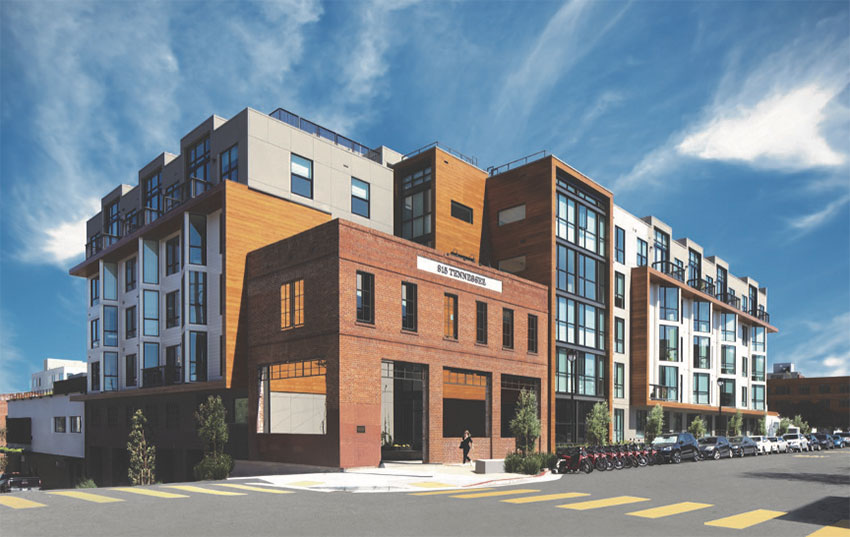
Photo by Chip Allen Photography; courtesy of All Weather Architectural Aluminum
815 Tennessee is a 5-story, 69-unit luxury residential project in the historic Dogpatch District in San Francisco that features matching aluminum doors and windows and incorporates a historic brick factory building in its overall design.
Aluminum Improving IEQ
The focus on incorporating indoor environmental quality (IEQ) in the built environment has gained traction over the past decade. IEQ is the marriage of sustainability building goals and the desire to improve overall occupant health and well-being in the built environment. IEQ spans all parts of the design and construction process, from accessibility to biophilia, and indoor air quality (IAQ) to noise control. This new focus on IEQ has brought about an awareness as to which products, materials, and design elements can enhance daylighting, improve acoustics, and promote positive behaviors around physical and mental well-being–all of these aspects are becoming integral to the conversation.
Aluminum framing has the potential to support IEQ. Because the healthy building concept includes sustainability within its principles, aluminum meets those needs as well, thanks to its inherent physical properties.
Education, health care, and retail building project designers have also begun to understand the healthy building movement as key to their design successes. Research has shown that, for owners, these healthy buildings generally lead to financial gains and expense reductions after they have been built through improved productivity, reduced sick days, and generally happier occupants.
Thanks to the material being lightweight, workable, recyclable, and corrosion-resistant, aluminum is a great choice for healthy and sustainable buildings. Recyclable materials are important in terms of potential demolition and reducing the amount of construction waste that cannot be reused.
Advanced window insulation technology, including the use of dense inert gases such as argon, krypton, and xenon in glazing cavities, helps prevent heat loss and increases soundproofing.
When it comes to thermal comfort, aluminum windows, and doors serve as part of a larger system. Because aluminum is a good conductor of heat, aluminum frames must be equipped with a thermal barrier that prevents heat from flowing inside to outside or vice versa depending on the climate, time of year, or time of day. Thermal barriers made from resins are incorporated into the aluminum profiles to allow the interior and exterior extrusions of a window or door to come together with minimum heat loss or gain.
Barriers can have thermal conductivities as much as 500 to 1,300 times lower than aluminum itself. The thermal performance of the entire window and door assembly is heavily influenced by that of the frame. Window and door design is intended to achieve the best possible daylight transmission while minimizing heat transmission. Window and door frame conductivity is a function of the frame material, geometry, and design (e.g., thermal barriers in metal frames). The thermal resistance of an aluminum frame is determined more by the surface area of the frame than by the thickness or projected area, as is the case with other frame materials.
A window or door frame profile with a simple, compact shape will perform better than a profile with fins and undulations. Aluminum can be extruded into very thin, very efficient frame profiles. The current technology with standard thermal barriers has improved aluminum frame U-factors from roughly 2.0 to about 1.0. Innovative thermal break designs combined with changes in frame design have also created high-performance frames that achieve U-factors even lower than 0.5.
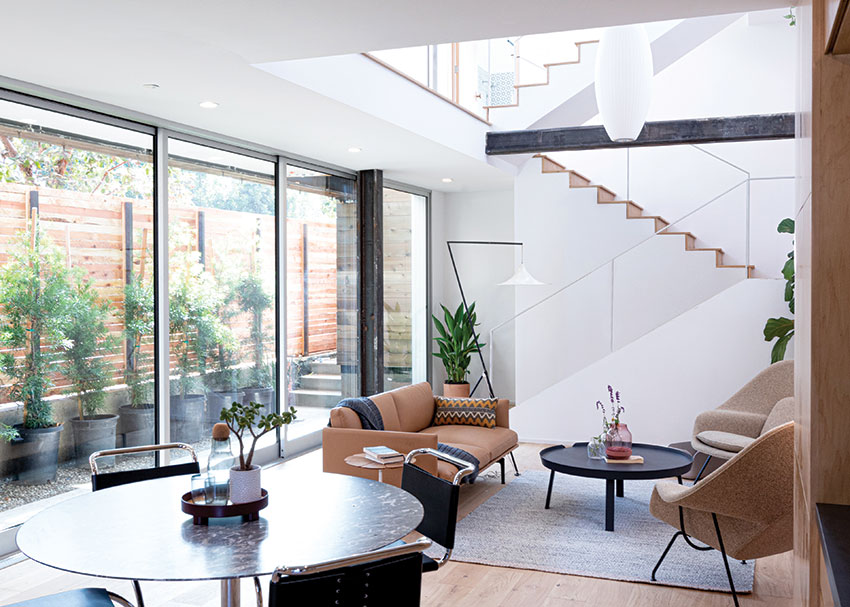
Photo by Ignacio Espigares; courtesy of All Weather Architectural Aluminum
Aluminum allows for a greater glazing-to-frame ratio, permitting more light into the space, an important consideration for IEQ and green building certification. The Wang Residence by Juan Saez Pedraja.
LEED CREDITS
Green building codes and programs, including LEED, now look at the overall indoor environmental quality of a building in addition to energy efficiency and other issues; this includes the benefits of daylighting and views for building occupants.
The importance of LEED certification in modern architecture can’t be stressed enough, and as a flexible, sustainable, and durable building material, aluminum plays well in achieving credits. This is especially true when architects select a single-source manufacturer that can provide a full complement of building products, like fenestration. A single-source manufacturer can simplify the process by providing the necessary documentation for an entire suite of products on a project.
LEED credit requirements cover the performance of materials as a whole and do not assess the performance of individual products or brands. Specific products or materials can only contribute toward earning LEED certification points; they cannot earn points individually themselves.
For aluminum fenestration, there is a wide range of potential credit points possible.
LEED v4 MR Credit: Building Product Disclosure and Optimization
One applicable example is the Materials and Resources (MR) credit Building Product Disclosure.
- Sourcing of Raw Materials (possible 2 points): The intent of this credit is to encourage the use of products and materials for which life-cycle information is available and that have environmentally, economically, and socially preferable life-cycle impacts, and to reward project teams for selecting products verified to have been extracted or sourced in a responsible manner.
- Material Ingredients (possible 2 points): The intent is to encourage the use of products and materials for which life-cycle information is available and that have environmentally, economically, and socially preferable life-cycle impacts; to reward project teams for selecting products for which the chemical ingredients in the product are inventoried using an accepted methodology, and for selecting products verified to minimize the use and generation of harmful substances; and to reward raw material manufacturers who produce products verified to have improved life-cycle impacts. It is easy to see how the positive attributes of aluminum windows and doors can contribute to credits in these categories.
- Environmental Product Declarations (possible 2 points): The intent of this credit is to encourage the use of products and materials for which life- cycle information is available and that have environmentally, economically, and socially preferable life-cycle impacts, and to reward project teams for selecting products from manufacturers who have verified improved environmental life-cycle impacts. We will look at achieving the first option:
Option 1. Environmental Product Declaration (EPD) (1 point) Use at least 20 different permanently installed products sourced from at least five different manufacturers that meet one of the disclosure criteria below.
- Product-specific declaration
- Products with a publicly available, critically reviewed life-cycle assessment conforming to ISO 14044 that have at least a cradle-to-gate scope are valued as one-quarter of a product for the purposes of credit achievement calculation.
- Environmental Product Declarations that conform to ISO 14025, 14040, 14044, and EN 15804 or ISO 21930 and have at least a cradle-to-gate scope.
- Industry-wide (generic) EPD: Products with third-party certification (Type III), including external verification, in which the manufacturer is explicitly recognized as a participant by the program operator, are valued as one-half of a product for purposes of credit achievement calculation.
- Product-specific Type III EPD: Products with third-party certification (Type III), including external verification in which the manufacturer is explicitly recognized as the participant by the program operator, are valued as one whole product for purposes of credit achievement calculation.
- USGBC-approved program: Products that comply with other USGBC-approved environmental product declaration frameworks. The credit also outlines another option that uses LCAs. The industry has conducted both LCAs and EPDs. There are a few changes to this credit in the newest LEED version, v4.1.
Many of the issues identified by LEED for credits are recognized by other building standards as well. The International WELL Building Institute (IWBI) is a public benefit corporation whose mission is to improve human health and well-being in buildings and communities across the world through its WELL Building Standard (WELL).
The WELL Building Standard also recognizes the importance of enhanced daylight access and requires projects to design spaces to integrate daylight into indoor environments so that daylight can be used for visual tasks along with electric lighting, and to provide windows and doors that connect the occupants with the outside world.
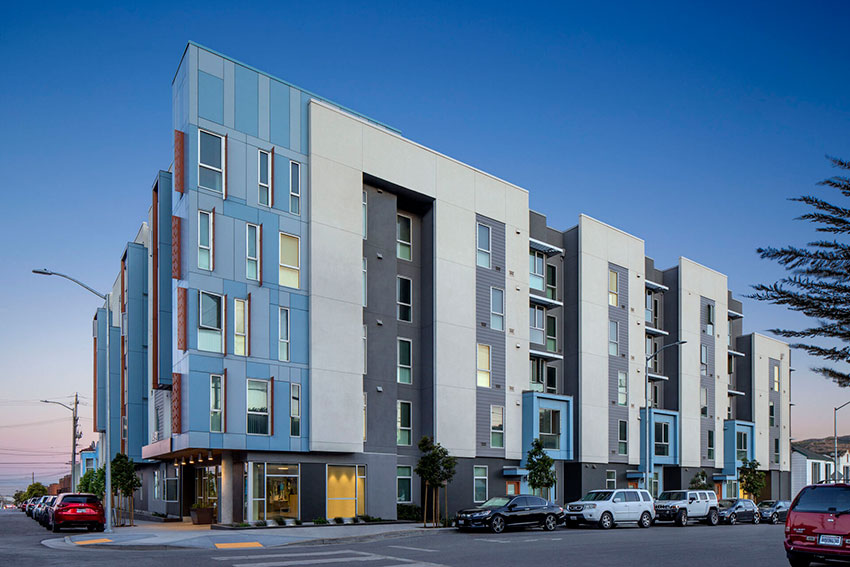
Photo by David Wakely; courtesy of All Weather Architectural Aluminum
Parcel Q is the first phase of the redevelopment of San Francisco’s largest public affordable housing site, Sunnydale. The project includes thermally enhanced aluminum windows to improve energy efficiency and durability.
CONCLUSION
In conclusion, aluminum emerges as a versatile and enduring choice for window and door products across a spectrum of construction projects. Its adaptability finds expression in commercial spaces, single-family residences, multifamily dwellings, healthcare facilities, and educational buildings. The physical resilience of aluminum stands out, providing a long-lasting and low-maintenance solution even in the face of challenging weather conditions. This inherent durability, coupled with its lightweight nature, makes aluminum a standout material that enhances the performance, durability, and sustainability of windows and doors.
Furthermore, the strategic decision to engage a single-source manufacturer for window and door products proves to be a pivotal choice in ensuring project success. The advantages are manifold, ranging from simplified ordering processes to streamlined project management. With consistent products and dedicated installation support, architects can focus on the creative and technical aspects of their designs, confident that the final outcome will align seamlessly with their vision.
Andrew A. Hunt is Vice President of Confluence Communications and specializes in writing, design, and production of articles and presentations related to sustainable design in the built environment. In addition to instructional design, writing, and project management, Andrew is an accomplished musician and voice-over actor, providing score and narration for both the entertainment and education arena. www.confluencec.com






















